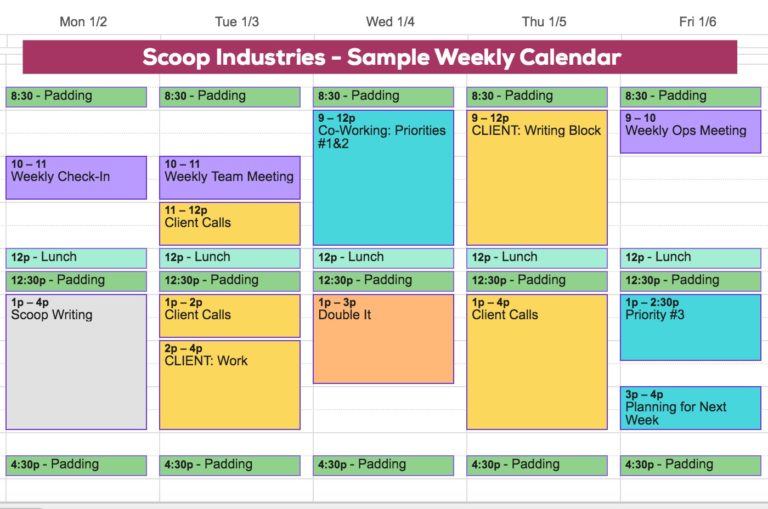
Search the site:
How to Plan Your Day When You Work with Clients
I’ve always considered myself a bit of a productivity powerhouse, as I love being able to make the most of the hours I work. I mean, what small business boss doesn’t? And so much of being truly productive comes down to how you plan your day.
Back when I first started my business, I had my fair share of productivity struggles as I tried to keep the plates spinning. Whatever I did, I couldn’t seem to knock out all the items on my to-do list, and that resulted in feeling like I had to work nights and weekends to catch up.
I finally came to realize that the way I’d learn productivity strategies back in my corporate days didn’t work for me as a boss, especially as one who works with clients.
My days were fragmented because I had a million and one things going on. There were simply more moving pieces and working with clients, more demands on my time.
The fact is, when you work with clients – your productivity and time management needs are different.
Your time needs to be managed in a way that lets you plan and prioritize your time so it works for you. That ensures you’re not running around doing a bunch of things that are going to drive you into the ground over time.
I know I didn’t start a business to be a stressed-out hot mess, and I’m sure you didn’t either. Learning how to better manage my days has been an evolution, but I wanted to share with you some specific strategies that have worked for me in the past few years:
It’s All About Priorities
Confession time. I’m a high achiever (I’m sure you feel me on that one!) which means I think I’m Superwoman and that I simply must do everything.
By learning how to stop doing everything, I’ve been able to create focus in a way that I never imagined possible. For me, this has been an exercise in identifying my priorities.
I’ve moved from big hairy goals that span a full year to short, focused periods where I work on a set of three goals for 12 weeks. Working in this way gives me the freedom to say no to things that aren’t in alignment with these goals and avoid being sucked into the next shiny object.
When you think about the next 12 weeks, you need to set goals for you and your business that are based on what will have the most impact. This may require some soul searching as you realize that things you “want” to do aren’t serving you.
As a services business owner, I like to lay out three goals every 12 weeks as follows:
- Client Focused Goal: What do I need to do to book more clients, bring in more revenue, serve clients better? By picking one area, I’m able to make an impact much faster and make the goal a reality.
- Business-Centric Goal: This is typically an internally focused goal that’s centered on marketing or systems that supports your bigger vision. This could be something like launching a podcast, doing Facebook Live weekly or another high impact activity.
- Personal Development: What do I need to focus on personally to move the business ahead? Do I need to develop a skill? Get more sleep? Take more time to be creative? Setting a goal here helps to ensure that I’m taking care of my needs because if I’m struggling, that’s not good for business.
Time Block Your Weeks
Have you ever had that moment around 1:00 p.m. where you feel like you’ve saved the world and you’re shattered? That’s what happens when you’re constantly switching back and forth all day long between tasks.
This is called context switching, and it means your brain is working way too hard. Each time you stop and start a task you’re losing valuable time and your productivity is impacted by up to 30%. Your brain needs to recalibrate and get back up to speed every time you restart.
This is why blocking out chunks of time each week has literally saved my brain. Instead of multitasking all day, every day, I work in a way that lets me focus on a single task at a time block.
Using this approach means no more switching back and forth, and it lets me carve out time to ensure I’m working on all of my priorities for that 12 week period.
There are a number of ways to do this, but I love creating theme days where I have dedicated blocks of time in the week for specific tasks. For example, Fridays I focus on operations. I know that each week, I have that time set aside to work on financials, team, systems and other items that need attention.
I also do this with phone calls. Each week, I block Tuesdays and Thursdays to be available for client, team and new business calls. That way I don’t have the expectation that I’m going to work on a technical project and get frustrated.

Ideally, look to set up an “ideal” calendar for your weeks so you’ve got a plan week in, week out. Also, once you’ve set your 12-week priorities, you can carve out time in your week to focus on them as well.
Add Padding Everyday
Before you decide this is all good in theory, but not realistic, I’m going to be honest with you. Managing your days, and ensuring you don’t get derailed, definitely takes some work.
For you to really manage your time, you need to create space for the day-to-day routine tasks you need to handle (like your email inbox) as well as for client communications.
This “padding” is key to you being the boss of your day and not letting something little throw you off track. Adding padding to your calendar every single day to check email, social media and handle routine day-to-day things is key. It’ll give you the peace of mind to know you’ve got time to handle those tasks.
Both Maggie and I have three padding blocks during the day of about 30 minutes each that we use for email, checking in with each other and our team, getting up to date on client projects and more. This time is a lifesaver as I don’t feel the need to “jump to” the second something happens, as I know that at Noon I’ve got time to deal with it.
Speaking of padding, don’t pack your calendar so tight every single day and week that one small client request is going to be a major drama. Plan for client priorities to come up and have a little extra padding so you can handle them with ease and grace.
Setting Kind, but FIRM Boundaries
Most people who run services businesses tend to be people pleasers, which can be amazing as it means you actually care about your clients and those around you.
But it’s a fine line between providing great service to your clients and being a total doormat. Enter boundaries, which are a must if you’re ever going to be more productive and be the master of your time.
Boundaries are the only way you’re going to stay sane if you work with clients. If you’re at your client’s beck and call, 24/7, you’re going to become resentful and burnt out over time. Setting boundaries starts with clearly establishing expectations.
Think about things like your response times. How fast can you turn things around? What types of deadlines are realistic? Communicating these basics with your clients will go a long way towards ensuring that you’re on the same page.
For example, for most clients, we have a 24 hour response time during the week and then 72 hours on the weekend. That means they can expect a timely response and don’t need to worry about it.
Figure out what your boundaries are and work towards setting these out in a way that’s firm, but kind, with your clients. If you’ve been working with certain clients for a while, it may take some time to reset, but it will be worth the work.
Also, remember you’re the boss, so if you block Mondays as a day for no calls, simply book your client calls the following day. You don’t need to explain or ask for permission. You get to decide and manage your time accordingly!
Plan Your Day Like a Boss
If there’s one lesson I’ve learned from running my business (and there have been oh so many!) it’s that time management and productivity are ALWAYS going to be a work in progress. No matter where you are today with your time management, there’s room for small, incremental improvements that can make a big impact over the course of a month or year. Start by focusing on how you plan your day and watch the momentum get rolling!

I’m Maggie Patterson (she/her), and services businesses are my business.
I have 20+ years of experience with client services, am a consultant for agency owners, creatives, and consultants, and vocal advocate for humane business practices rooted in empathy, respect, and trust.
Help Not Hype

Tired of the same old BS business advice?
I got you with weekly emails packed full of proven strategy that makes a real difference in your service business.









